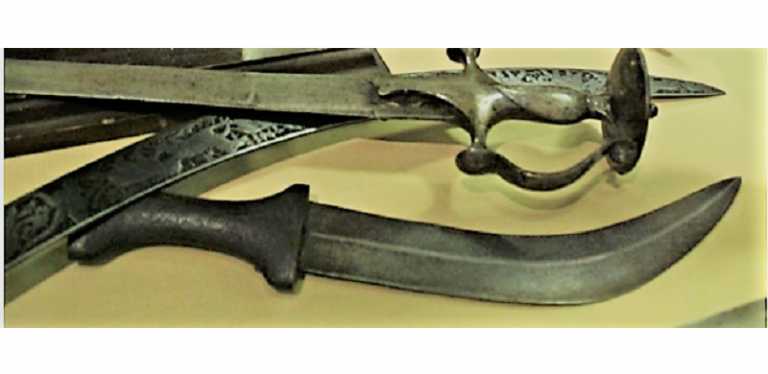
Payment to soldiers changed many hands – from the Mir’s Munshi to the Sardars and then to family heads and finally to individuals.
By Zaffar Junejo
A writer passes through various emotional experiences. Sometimes, there is no inspiration. Occasionally, they are not sure what to write, or wait for a magical opening sentence. Since the last few months, I passed through these experiences. A few months ago, I had planned to write about the weapons of the people who fought at the Hyderabad battles in 1843. But somehow, I forgot about it. Day before yesterday, I came back to the abandoned topic. I was, however, stuck trying to find a writing flow.
Amid this perplexity, I remembered my grandfather’s double-barrel shotgun, which was made in Birmingham, England.
I wondered why the shotgun came into my mind. What was its connection with the present topic? I recalled Professor Dr. Priya Satia’s book Empire of Guns, especially its chapter titled, ‘Who Made Guns?” The chapter described how Birmingham was famous for manufacturing shotguns. I guess the shotgun came into my mind because of its foreign origin. I immediately took Empire of Guns from my bookshelf, flipped through its pages, and found this: “along with the EIC [East India Company], the importers of England’s weapons were Indian States. Suddenly, an idea came into my mind: did the Talpur Amirs purchase any weapons from the British? The question pushed me to pick Nathan Crow’s book, Crow’s Account of Sind. He states in his book that when he visited the Durbar of Hyderabad in March 1800, he presented a double-barrel gun, a single-barrel gun and a few pistols to Mir Fateh Ali Khan.
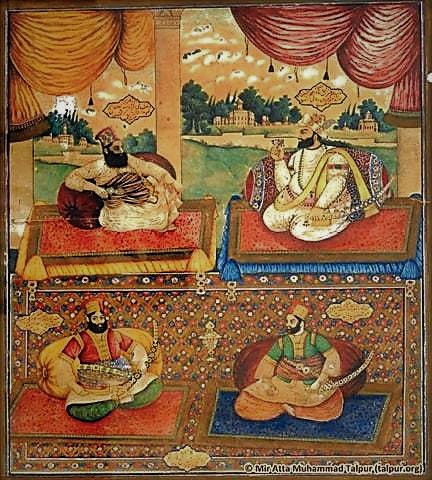
I was surprised to read his words about Mir Fateh Ali Khan Talpur: “he has huge and variant artillery, consisting mainly of purchases and gifts from the English, Portuguese and Dutch manufactures.” In the same book, the author stated that in April 1800, the Amirs of Sindh purchased 400 mortar shells from the East India Company. The total weight of the shells was 532 Karachi maunds and 20 seers, and these shells were of varying grades. The above paragraph gives us confidence that the Amirs were aware of European weapons. Therefore, a popular impression that the rulers of Sindh simply did not know about modern weaponry cannot be entertained as an explanation for the disparity in armaments.
On the foot soldiers, the author wrote: “Talpur family’s total strength was forty thousand foot soldiers,” and “in the marching its number could excel any troops in the world.” However, one must understand that it was not a regular army or a state-owned institution. Usually, the Amirs gathered common people through privileged chieftains/sardars who obliged and assembled their able-bodied people. In pre-British India, body features, physical strength and courage were considered important for a prospective soldier. Likewise, in Sindh, the Amirs also valued physical strength as a standard for the soldiery, although they didn’t retain regular troops, except a considerable number of personal guards or hunting bands. The soldiers and guards were usually equipped with old matchlocks, traditional swords and axes.
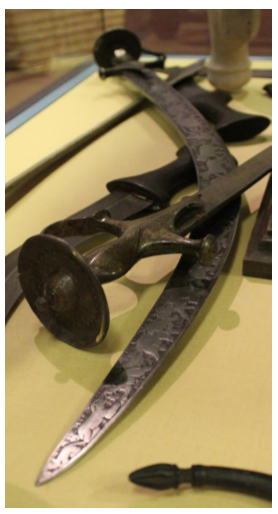
About the payment of soldiers, Thomas Postans in his book, Personal Observations on Sindh: The Manners and Customs of Its Inhabitants; and Its Productive Capabilities, writes: “if troops are called, then the Amirs would pay them three English pence per day to a foot soldier, and a horseman was paid double of the foot soldier, along with grains for the horse.” However, it must be noted that it was not a monthly payment. It was ‘Battle-Participation-Fee,’ and it was paid to the local Sardars who brought their men. On the other hand, EIC’s army was paid regularly, which assured daily sustenance.
Imagine the impact of a monthly payment and the guaranteed availability of food on the recruits belonging to an agrarian society, where otherwise nothing was certain, as earnings were seasonal and meagre. Therefore, the EIC created trust among its soldiers. On the contrary, the Amirs’ payment changed many hands, from the Mir’s Munshi to the Sardars and then to family heads and finally to individuals. Therefore, they always doubted about the amount that the Sardars got in their names, and what percentage was deducted by them. Interestingly, there was frequent rumours that some tribes were getting additional perks. These rumours were propagated by Sardars themselves, just to belittle their rival Sardars.
J. Bryant in his article “Asymmetric Warfare: The British Experience in Eighteenth-Century India” published in The Journal of Military History, April 2004, argues that “EIC’s army relied on the power of fire, and native armies applied the power of the force – sword, arrows, daggers, and axes.” Additionally, he argued that “EIC’s army’s skills were uniform, and its operations were systematic.”
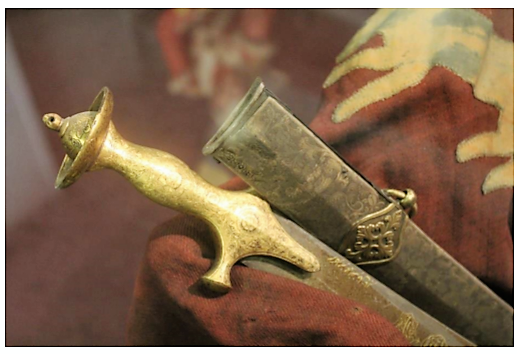
In addition to that the EIC had modern weapons and uninterrupted supply chain mechanism. The annals of history reveal that in the 1800s, 3,037,644 barrels and 2,879,203 locks were made and around 1,000,000 items were delivered to the East India Company. On the contrary, such was not the case with native kings and states; they did not have manufacturing units or reliable supply chain mechanisms because local foundries and weapon manufacturing networks were destroyed by the EIC.
I was interested in knowing about the weapons of the Talpur Amirs’ soldiers. I read a considerable number of books and explored websites. I contacted the administrators of various Victorian museums, and finally visited the Cheshire Military Museum. Moreover, I downloaded a list of weapons which were used by Sindhi soldiers at Battles of Hyderabad. These weapons were gathered by the EIC army, then listed and displayed in museums. I noticed that commonly found individuals’ weapons were various types of daggers, swords, and shields. The list shows a description of each weapon that was gathered by EIC’s soldiers. One dagger’s physical description stated: “a curved blade, having a central ridge, and concave-shaped handle.” Another mentioned: “a thin double-edged blade that tapers to a curve, handle is made of wood and decorated with a curved brass top engraved with leaf-shaped patterns.”
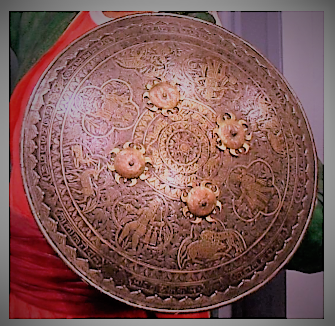
Apart from daggers, swords were also found and collected. One of the descriptions stated: “Indian origin, it was taken by an unidentified individual from Amir Nasir Khan Talpur at the Battle of Miani, 1843.” Another sword was described as follows: “a sword hilt with disc-pommel is decorated in gold koftgari with floral patterning. Its curved blade is marked with cartouches in Arabic and a maker’s mark. The wooden scabbard is ornately decorated with floral patterning and decorative mounts with loops.” The powder flasks were also collected; these are important parts of muzzle-loading guns. The record described one of the flasks: “it has a slender-curved shape featuring a brass mechanism that is pressed to dispense the powder within. The left-hand tip of the flask has a pointed acorn shaped finial which may be removable and the source through which to initially fill the flask.”
At the battle grounds, shields were also found. The record stated about one of the gathered shields: “the shield gilded, with four central rings patterned with floral and animal motifs surrounded by four bosses edged with crescent shapes. A larger circular band decorated with animal and military figures, with three thinner bands leading towards the outer border with alternate patterns, including petals, couples of birds, semi-circular scrolls and chevrons. The outer edge is slightly raised.”
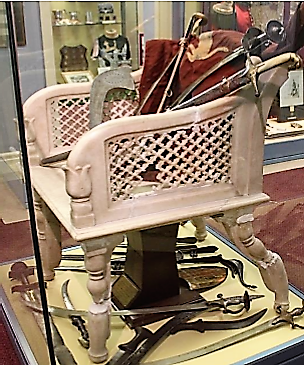
Unrelated to military affairs but relevant to our discussion, one item on display was an Alabaster chair called the “Amir’s Chair of State.” The physical description stated: “a chair carved of alabaster on four turned legs with fretwork panels on the back and sides. Its curved arm rests terminate into decorative tulips on both sides.” The record revealed that it was presented to General Sir Charles Napier. His granddaughter Mrs. Lionel Oakes gave it to the 22nd Regiment in 1926.
Let me end the article by agreeing with scholars of the British Empire that the Raj ruled in India through a combination of effective leadership, a policy of divide and rule, the use of mercenaries, the exploitation of Indian revenues, uprooting of local entrepreneurs and superiority of firepower. I must add that Sindh (and other native states) lost their wars because they lacked modern armies, war experience, war strategy and superior weapons.
____________________
 Dr. Zaffar Junejo is Research Scholar, Department of History University of Malaya, Malaysia. Mr. Junejo apart from scholarly contribution also writes for popular media. He could be accessed at: Email junejozi@gmail.com, Cell/WhatsApp +92 334 045 5333 Skype Zaffar.Junejo Facebook facebook.com/zaffar.junejo
Dr. Zaffar Junejo is Research Scholar, Department of History University of Malaya, Malaysia. Mr. Junejo apart from scholarly contribution also writes for popular media. He could be accessed at: Email junejozi@gmail.com, Cell/WhatsApp +92 334 045 5333 Skype Zaffar.Junejo Facebook facebook.com/zaffar.junejo
Courtesy: The Friday Times Naya Daur Lahore
The Analysis Posts are inspired and informative for the users